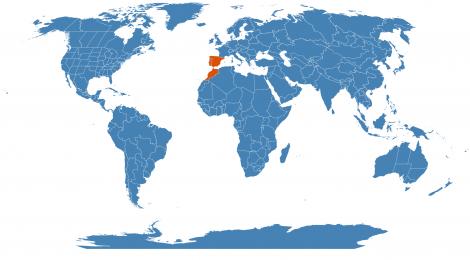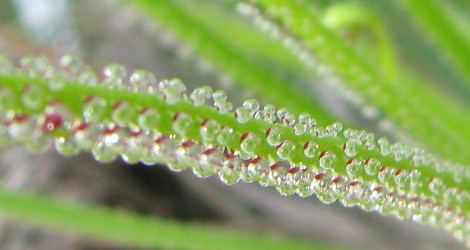Accession Data:
Drosophyllum lusitanicum Link
- Common Name: Portuguese Sundew
- Family: Drosophyllaceae
- Country of Origin: C. & S. Portugal to SC. & S. Spain (incl. Gibraltar), N. Morocco

- Habitat: poor rocky or sandy hillsides near the sea
- Description: Carnivorous plant with 'sticky hair' trap mechanism. Unusual in that it is found in arid areas, not the wet boggy sites most carnivores inhabit.
Another unusual characteristic that sets this species apart is that the new leaves unfurl with circinate vernation - typical of new fern fronds opening in the form of fiddleheads. Some cycads exhibit this as well as numerous species of the closely related carnivorous genus Drosera. However, in Drosophyllum, the new leaves unfurl from the outside rather than the inside like all other known examples of circinate vernation.
- Culture: The basic requirements of Drosophyllum are similar to those of many other carnivorous plants: as much full sun as possible (at least half-day), poor, acidic soil (5 peatmoss : 2 perlite : 1 horticultural charcoal), and pure water (rain or deionized). The plants resent being disturbed, so sow the seeds directly in fairly large (6-7") containers, where they can be left for the long term, or use peat pots that can be sunken into new soil, to minimize root disruption.
Drosophyllum comes from a Mediterranean climate, and grows most vigorously in the fall, winter and spring months. Warm days (65-75 F) and cool nights (50 F) are best. Unlike many carnivorous plants, Drosophyllum can have problems with fungal diseases if kept too wet. Let the soil surface dry slightly between waterings, and provide good air circulation and moderate humidity levels. Never leave the pots standing in water.
Summer dormant - mist only during summer months to simulate dew
Accession Data:
- Accession # 200600002
- Source: Matt Opel ex ICPS seedbank
- Accession Date: 02-07-2006
- Bench: 2310 - Temperate Carnivores
- Currently: active - healthy
- Qty: 4 confirmed on 07-21-2024
Classification:
- Division: Magnoliophyta
- Class: Magnoliopsida
- SubClass: core eudicots
- Order: Caryophyllales
- SubOrder:
- Family: Drosophyllaceae
- SubFamily:
- Tribe:
- SubTribe:
Flowering Data:
This accession has been observed in bloom on:| Year | Jan | Feb | Mar | Apr | May | Jun | Jul | Aug | Sep | Oct | Nov | Dec | ||||||||||||||||||||||||||||||||||||||||
|---|---|---|---|---|---|---|---|---|---|---|---|---|---|---|---|---|---|---|---|---|---|---|---|---|---|---|---|---|---|---|---|---|---|---|---|---|---|---|---|---|---|---|---|---|---|---|---|---|---|---|---|---|
| 2024 | ||||||||||||||||||||||||||||||||||||||||||||||||||||
| 2023 | ||||||||||||||||||||||||||||||||||||||||||||||||||||
| 2022 | ||||||||||||||||||||||||||||||||||||||||||||||||||||
| 2021 | ||||||||||||||||||||||||||||||||||||||||||||||||||||
| 2020 | ||||||||||||||||||||||||||||||||||||||||||||||||||||
| 2019 | ||||||||||||||||||||||||||||||||||||||||||||||||||||
| 2018 | ||||||||||||||||||||||||||||||||||||||||||||||||||||
| 2017 | ||||||||||||||||||||||||||||||||||||||||||||||||||||
| 2016 | ||||||||||||||||||||||||||||||||||||||||||||||||||||
| 2015 | ||||||||||||||||||||||||||||||||||||||||||||||||||||
| 2014 | ||||||||||||||||||||||||||||||||||||||||||||||||||||
| 2013 | ||||||||||||||||||||||||||||||||||||||||||||||||||||
| 2012 | ||||||||||||||||||||||||||||||||||||||||||||||||||||
| 2011 | ||||||||||||||||||||||||||||||||||||||||||||||||||||
| 2010 | ||||||||||||||||||||||||||||||||||||||||||||||||||||
| 2009 | ||||||||||||||||||||||||||||||||||||||||||||||||||||
| 2008 | ||||||||||||||||||||||||||||||||||||||||||||||||||||
| 2007 | ||||||||||||||||||||||||||||||||||||||||||||||||||||
References (internal):
- Carnivorous Plants
- Plants with Extrafloral Nectaries
- EEB 3203 - Developmental Plant Morphology
- Plants used in EEB 2244 - General Ecology
References (external):
- The Portuguese Sundew (Drosophyllum lusitanicum Link.) in nature and cultivation by Jan Flísek & Kamil Pásek
- The Plant List (2013). Version 1.1. Last accessed on Thursday, September 28, 2017.
- WCSP (2017). World Checklist of Selected Plant Families. Facilitated by the Royal Botanic Gardens, Kew. Last accessed on Thursday, September 28, 2017.
- The Carnivorous Dewy Pine at In Defense of Plants. Last accessed Monday, August 20, 2018.
data regenerated on Sun, 21 Jul 2024 11:39:05 -0400 [bcm v4.0]
Images:

Additional images for this accession:
Click on thumbnails to enlargeCurrent Accessions in the Drosophyllaceae
W/C = Wild Collected = indicates flowering in past 14 days
= indicates flowering in past 14 days
 = images available for this accession
= images available for this accession
 = map available for this accession
= map available for this accession
 = accession added within past 90 days
= accession added within past 90 days




